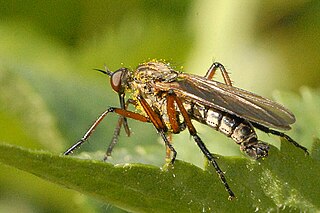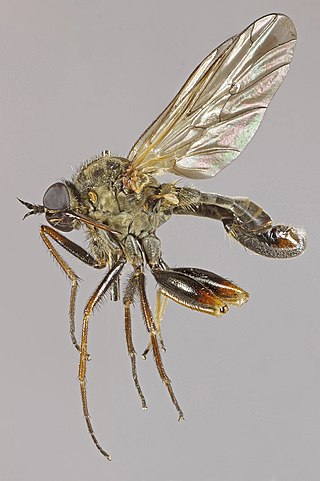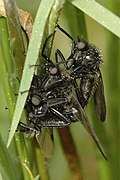
Empis livida is a species of fly in the family Empididae. It is included in the subgenus Kritempis of the genus Empis. Males range from 7.5 to 9.3 millimetres, females 7.5 to 10.2 millimetres. The male's abdomen is brownish, and his wings appear faintly brown and clouded. The female's abdomen is gray and her wings are clear. E. livida lives in hedgerows, feeding on the nectar of several species of Rosaceae, several species of Asteraceae, and Heracleum sphondylium nectar; they also feed on other insects. They live all across temperate and Northern Europe, the only species with such a wide distribution. E. livida larvae are also carnivorous and live in damp soil and leaf litter. Adults fly in between April and July.

Empis tessellata is a species of dance fly, in the fly family Empididae. It is included in the subgenus Euempis.

Empis picipes is a species of dance flies, in the fly family Empididae. It is included in the subgenus Euempis. It is found from Great Britain east to Poland, Slovakia and Hungary and from Fennoscandia south to Italy. It is not found on the Balkan Peninsula, except Greece.

Empis opaca is a species of dance flies, in the fly family Empididae. It is found in most of Europe, except the Balkan Peninsula and the Iberian Peninsula.

Empis femorata is a species of fly in the family Empididae. It is included in the subgenus Euempis. It is found in the Palearctic.
Empis pilicornis is a species of fly in the family Empididae. It is included in the subgenus Euempis. It is found in the Palearctic.
Empis basalis is a species of fly in the family Empididae. It is included in the subgenus Euempis. It is found in the Palearctic.
Empis erosa is a species of fly in the family Empididae. It is included in the subgenus Euempis. It is found in the Palearctic.
Empis calcarata is a species of fly in the family Empididae. It is included in the subgenus Euempis. It is found in the Palearctic.
Empis mikii is a species of fly in the family Empididae. It is included in the subgenus Euempis. It is found in the Palearctic.
Empis fiumana is a species of fly in the family Empididae. It is included in the subgenus Euempis. It is found in the Palearctic.
Empis kerteszi is a species of fly in the family Empididae. It is included in the subgenus Euempis. It is found in the Palearctic.
Empis mirandica is a species of fly in the family Empididae. It is included in the subgenus Euempis. It is found in the Palearctic.
Empis morenae is a species of fly in the family Empididae. It is included in the subgenus Euempis. It is found in the Palearctic.
Empis sericans is a species of fly in the family Empididae. It is included in the subgenus Euempis. It is found in the Palearctic.
Empis gaigeri is a species of fly in the family Empididae. It is included in the subgenus Euempis. It is found in the Palearctic.
Empis morio is a species of fly in the family Empididae. It is included in the subgenus Euempis. It is found in the Palearctic.
Empis spiralis is a species of fly in the family Empididae. It is included in the subgenus Euempis. It is found in the Palearctic.
Empis scotica is a species of fly in the family Empididae. It is included in the subgenus Pachymeria of the genus Empis. It is found in the Palearctic.
Empis scutellata is a species of fly in the family Empididae. It is included in the subgenus Xanthempis. It is found in the Palearctic.









